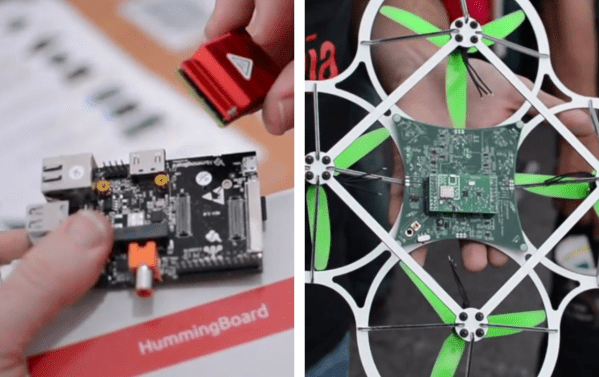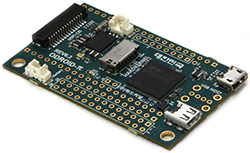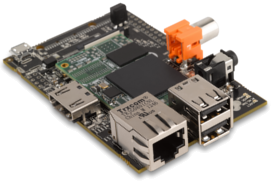Freescale was very kind to Hackaday at Maker Faire this weekend, showing off a few boards and answering a few questions about why old Motorola application notes aren’t available on the Internet.
The Hummingboard from SolidRun comes in an oddly familiar form factor to anyone who has ever handled a Raspberry Pi. It also has an interesting feature: the CPU is on a small module, allowing anyone to upgrade the chipset to something significantly more powerful. In the top of the line configuration, it has a two core iMX6 CPU with a Gig of RAM, LVDS output, and Gigabit Ethernet. All the complex bits for this board are on a single module, allowing anyone to take the module and put it in another project, a la the Intel Edison.
Also in the Freescale booth was the pcDuino, a dual core ARM Cortex A7 with Ethernet, WiFi, and a SATA, with Arduino form factor pinouts. It’s a somewhat niche product, but being able to stack shields on something comparable to a Raspi or BeagleBone is a nice feature.
[Trey German] from Texas Instruments showed off some very cool stuff, including a quadcopter board for a Launchpad microcontroller. This isn’t a board with an IMU and a few servo outputs; this is the whole shebang with a frame, motors, and props. The frame was cut from some odd composite that’s usually used for road signs, and even though it wasn’t flying at the Faire (nothing was flying, by the way), it’s pretty light for a quad made at a board house.
Also from TI was their CC3200 dev board. This is a single chip with an ARM Cortex M4 and a WiFi radio that we’ve seen before. The CC3200 runs TI’s Wiring/Arduino inspired development environment Energia, and at about $30 for the CC3200 Launchpad board, it’s an easy and cheap way to build an Internet of Things thing.


 A few years ago, Broadcom had a pretty nice chip – the BCM2835 – that could do 1080 video, had fairly powerful graphics performance, run a *nix at a good click, and was fairly cheap. A Broadcom employee thought, “why don’t we build an educational computer with this” and the Raspberry Pi was born. Since then, Broadcom has kept that chip to themselves, funneling all of them into what has become a very vibrant platform for education, tinkering, and any other project that could use a small Linux board. Recently, Broadcom has started to sell the BCM2835 to anyone who has the cash and from the looks of it,
A few years ago, Broadcom had a pretty nice chip – the BCM2835 – that could do 1080 video, had fairly powerful graphics performance, run a *nix at a good click, and was fairly cheap. A Broadcom employee thought, “why don’t we build an educational computer with this” and the Raspberry Pi was born. Since then, Broadcom has kept that chip to themselves, funneling all of them into what has become a very vibrant platform for education, tinkering, and any other project that could use a small Linux board. Recently, Broadcom has started to sell the BCM2835 to anyone who has the cash and from the looks of it, 









